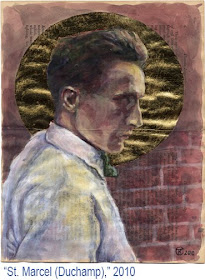I have a friend who is a traditionalist when it comes to his taste in art. Craftsmanship is an essential element for him. This automatically knocks out of contention anything that is fabricated for an artist by a craftsperson not typically associated with art production; works like Donald Judd’s, for instance. For my friend, it all goes back to Marcel Duchamp’s Fountain. It is as if Duchamp’s urinal was a virus that somehow infected the art production of the twentieth century.
I can’t fully agree with my friend. I join his complaints about the lack of craftsmanship evident in some contemporary art. I don’t, however, think we should solely blame Duchamp for this. The emphasis of content over craft in many art schools during the last four or five decades has done much more to erode the state of craftsmanship and technique than the use of so-called Readymades. Still, I don’t like to narrow art to such antiquated categories as pure painting or sculpture. Or maybe it is more that I make room for a wider variety of non-consecrated materials. The hardware store palette of Tim Hawkinson comes to mind.
However, the exhibition of Duchamp’s Fountain did set into motion a chain of events that altered art making. In the early days of the twentieth century Picasso and Braque had already begun breaking down the picture plane. The use of “real” materials in their Cubist collages paved the way for Duchamp’s Readymades. It was still a great leap from collage to the Readymade and that is the primary reason why it took over a generation for the art world to catch up with Duchamp’s concepts. By that time he was playing chess.
One can’t help but appreciate Duchamp, nonetheless. He challenged the centuries old traditions of art making and essentially took us back the square one. Before humans ever began manipulating clay, stone, or wood—or used pigments and minerals to draw images on cave walls—they did something humans from all times have. They noticed the resemblances of human and animal forms in trees, rocks, and clouds. Eventually they accentuated what they found in nature and that process turned into sculpture.
I’m not saying that R. Mutt (a.k.a. Duchamp) noticed some natural form in a urinal and thus plucked it from obscurity to share his revelation with the world. He did, however, perform that very human act of designating an object as art. In many respects nothing had changed. The designation of art objects has always been about the setting apart of items for special—or holy—use or consideration. All ancient religious practices did just this. The philosophies of the twentieth century merely replaced the old religions with a new one. The cathedral and temple were replaced with the art museum. Duchamp was bold in his statement and his ideas gradually infiltrated the whole culture.
A continuation of this shift in art making came several decades later with Robert Rauschenberg. His “Combine Painting” Monogram is a seminal work because it further initiated the breakdown of art categories and established materials. The use of a taxidermied angora goat—paint spattered though it was—was really a nod to Duchamp’s Readymades. When the canvas, and the goat, came down off the wall and settled on the floor the viewer was forced to consider whether this was a painting or a sculpture. One of the best aspects of these Combine works is that they are neither painting nor sculpture; they are simultaneously both.
The work of Rauschenberg is sometimes designated as Neo-Dada (the movement with which Duchamp was associated), but it could equally be categorized as Pre-Pop. it borrows elements from Duchamp but also prefigures the work of the Pop artists. One automatically thinks of banal, everyday objects when the name of Andy Warhol arises. Though Warhol returned to art with representational imagery, his choice of subject matter obviously owed a great debt to the work of artists like Duchamp and Rauschenberg. Each of these artists based their work in the ordinary and mundane.
Long before any of these artists changed the rules concerning what we consider viable artistic subject matter, the masses had objected to the use of “real,” common subjects or objects. We may recall that it was not the portrayal of a nude in Manet’s Olympia or Luncheon on the Grass that so scandalized the sensibilities of the Parisian bourgeoisie. It was that the model was a common woman—and a prostitute to boot. What remained transformative in the artworks of countless others who followed was the continued use of the great themes found in masterpieces from centuries prior.
That transformative element is why I am drawn to works by artists like Damien Hirst. It is why these earlier artists have been included among the figures in my Saints, Sinners, Martyrs, & Misfits paintings. They moved art forward in a similar way to what the seventeenth century Dutch still life and genre painters had. The stuff of everyday life is reconsidered in light of the big philosophical questions of life. When this happens we are able to encounter the transformative in the quiet, fleeting moments of an average day. If art and artists can cause us to do that then something great has been achieved.




No comments:
Post a Comment